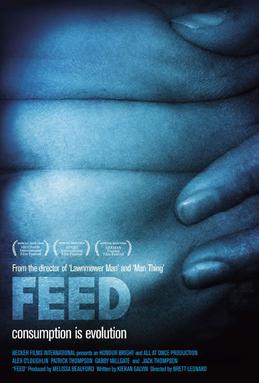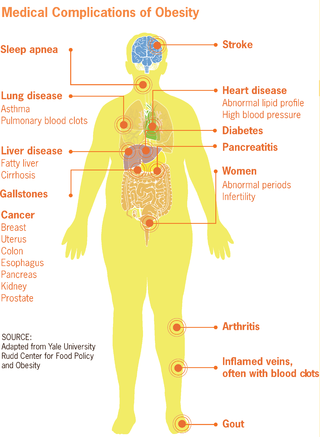
Human sexual activity, human sexual practice or human sexual behaviour is the manner in which humans experience and express their sexuality. People engage in a variety of sexual acts, ranging from activities done alone to acts with another person in varying patterns of frequency, for a wide variety of reasons. Sexual activity usually results in sexual arousal and physiological changes in the aroused person, some of which are pronounced while others are more subtle. Sexual activity may also include conduct and activities which are intended to arouse the sexual interest of another or enhance the sex life of another, such as strategies to find or attract partners, or personal interactions between individuals. Sexual activity may follow sexual arousal.

The fat acceptance movement is a social movement which seeks to eliminate the social stigma of obesity. Areas of contention include the aesthetic, legal, and medical approaches to fat people.

Sexual fetishism or erotic fetishism is a sexual fixation on a nonliving object or body part. The object of interest is called the fetish; the person who has a fetish for that object is a fetishist. A sexual fetish may be regarded as a non-pathological aid to sexual excitement, or as a mental disorder if it causes significant psychosocial distress for the person or has detrimental effects on important areas of their life. Sexual arousal from a particular body part can be further classified as partialism.

A chub is an overweight or obese gay man who identifies as being part of the chubby culture. Although there is some overlap between chubs and bears, chubs have their own distinct subculture and community. There are bars, organizations and social events specifically catering to this subculture, which allows members of the community to socialize with each other and develop social networks.

Foot fetishism, also known as foot partialism or podophilia, is a pronounced sexual interest in feet. It is the most common form of sexual fetishism for otherwise non-sexual objects or body parts.

As a paraphilia, breast fetishism is a sexual interest that focuses exclusively on the female breasts, and is a type of partialism. The term breast fetishism is also used in the non-paraphilic sense, to refer to cultural attention to female breasts and the sexuality they represent.
Fat fetishism or adipophilia is a sexual attraction directed towards overweight or obese people due primarily to their weight and size.

Erotic humiliation is a consensual psychological humiliation performed in order to produce erotic excitement or sexual arousal. This can be for either the person(s) being humiliated and demeaned or the person(s) humiliating, or both. It is sometimes performed before spectators, including through pornography and webcam modeling. It may be part of BDSM and other sexual roleplay, or accompanied by the sexual stimulation of the genitals of one or both parties in the activity.

Feed is a 2005 Australian crime-horror film directed by Brett Leonard. The plot involves a police investigation of non-consensual feederism. The film explores themes of love, dominance and submission.

"Big Beautiful Woman" is a positive (non-pejorative) term for an overweight woman.
Sizeism or size discrimination is unjust or prejudicial treatment directed at people based on their size.

Human body shape is a complex phenomenon with sophisticated detail and function. The general shape or figure of a person is defined mainly by the molding of skeletal structures, as well as the distribution of muscles and fat. Skeletal structure grows and changes only up to the point at which a human reaches adulthood and remains essentially the same for the rest of their life. Growth is usually completed between the ages of 13 and 18, at which time the epiphyseal plates of long bones close, allowing no further growth.
Human sexuality covers a broad range of topics, including the physiological, psychological, social, cultural, political, philosophical, ethical, moral, theological, legal and spiritual or religious aspects of sex and human sexual behavior.

Obesity is a risk factor for many chronic physical and mental illnesses.
An Asian fetish is a strong sexual or romantic preference for people of Asian descent or heritage. The term usually refers to women specifically of East or Southeast Asian descent, though this may also include those of South Asian descent.
Social stigma of obesity is broadly defined as bias or discriminatory behaviors targeted at overweight and obese individuals because of their weight and a high body fat percentage. Such social stigmas can span one's entire life, as long as excess weight is present, starting from a young age and lasting into adulthood. Studies also indicate overweight and obese individuals experience higher levels of stigma compared to other people.
Body shape refers to the many physical attributes of the human body that make up its appearance, including size and countenance. Body shape has come to imply not only sexual/reproductive ability, but wellness and fitness. In the West, slenderness is associated with happiness, success, youth, and social acceptability. Being overweight is associated with laziness. The media promote a weight-conscious standard for women more often than for men. Deviance from these norms result in social consequences. The media perpetuate this ideal in various ways, particularly glorifying and focusing on thin actors and actresses, models, and other public figures while avoiding the use or image of overweight individuals. This thin ideal represents less than 15% of the American population.

Concepts of race and sexuality have interacted in various ways in different historical contexts. While partially based on physical similarities within groups, race is understood by scientists to be a social construct rather than a biological reality. Human sexuality involves biological, erotic, physical, emotional, social, or spiritual feelings and behaviors.
Obesity is defined as an abnormal accumulation of body fat, usually 20% or more over an individual's ideal body weight. This is often described as a body mass index (BMI) over 30. However, BMI does not account for whether the excess weight is fat or muscle, and is not a measure of body composition. For most people, however, BMI is an indication used worldwide to estimate nutritional status. Obesity is usually the result of consuming more calories than the body needs and not expending that energy by doing exercise. There are genetic causes and hormonal disorders that cause people to gain significant amounts of weight but this is rare. People in the obese category are much more likely to suffer from fertility problems than people of normal healthy weight.
The social stigma of obesity, can be defined as the systemic oppression of and discrimination against people who may be considered overweight, obese, or fat. Fatphobia exists in many forms and presents itself in both institutional and interpersonal circumstances. According to numerous academics, fatphobia or general anti-fat bias is common and pervasive. Fatphobia negatively impacts the attitudes and behaviours of individuals towards those considered to be overweight or obese. Employment, relationships, and medical care are some facets of daily living that are all known to be negatively impacted by fat-phobic rhetoric or anti-fat assumptions. Fatphobia is produced and spread in many ways, including through advertising and popular media such as television shows. According to a number of scholars, television shows in North America both underrepresent and misrepresent fat people which (re)produces fatphobic rhetoric












